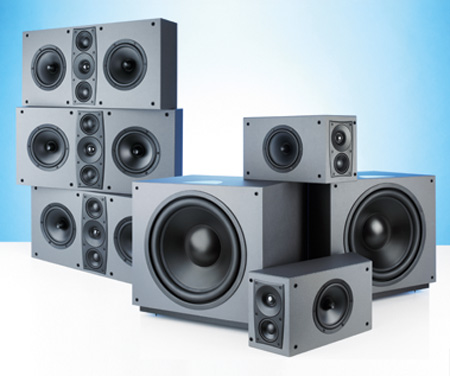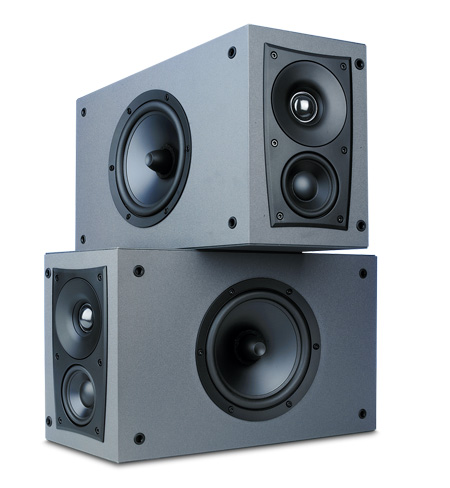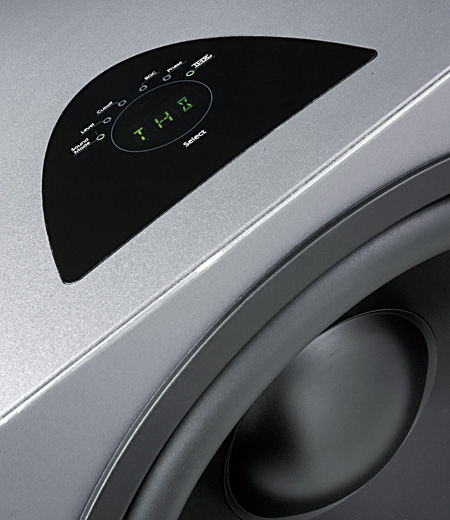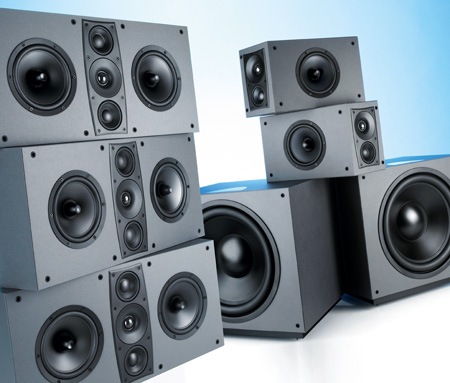What Hi-Fi? Verdict
Despite its limitations with music, this is a simply wonderful speaker package
Pros
- +
Staggering power with effortless scale
- +
wonderful clarity and cohesion
- +
value
Cons
- -
Not nearly so successful in stereo
- -
some might be put off by the plain finish
Why you can trust What Hi-Fi?
Even by the purposeful standards of most home cinema kit, the Jamo D 600 THX Ultra 2 home cinema speaker package looks like it means business.
Even by the purposeful standards of most home cinema kit, the Jamo D 600 looks like it means business. With its battleship-grey paint, swathes of matte-black drive units and twin subwoofers, it appears to have more in common with professional studio monitors than more conventional 5.1 systems in its price class, such as the Award-winning B&W CM9 Theatre.
In fairness, once the Jamo’s five main speakers have been mounted to your wall (via built-in brackets) and their speaker grilles are fitted, the system becomes altogether more unobtrusive, although you’d have to be in a charitable mood to call it ‘stylish’.
Aesthetic considerations apart, the far more important point at hand is that for some, this stupendous speaker package will be the perfect buy. Simply put, we can’t think of any rival for its home cinema ability at anywhere near the price.
The D 600’s success stems from its distinctive configuration, which reflects the specific design requirements of
the stringent performance standards it has been developed to meet. The Jamo is one of only a few THX Ultra 2 speaker systems available to British buyers, and instead of the large floorstanding speakers commonly used in this price class, it employs five bass-restricted main speakers for front and rear effects. That’s not a compromise – at least, not
in THX’s view – but a positive benefit. The front three speakers are identical
D 600 LCR (left, centre, right) designs and, argues THX, that approach goes a long way towards ensuring a properly integrated and cohesive soundfield.
Distinctive speaker design
The Jamo’s D 600 SUR rear speakers, meanwhile, differ only in the way that they disperse sound around the room (they’re dipole designs – see our panel, overleaf), and in the fact they sport only one 16.5 bass/midrange driver apiece, rather than the pair of drivers found in their front-speaker partners.
All five speakers are designed to ignore all frequencies below a fairly modest 80Hz. That, argues THX, has two advantages: first, it allows for each main speaker to be manageably small, and so easier to install without undue sonic compromise in most living rooms. And second, it puts the burden of the sonic ‘heavy-lifting’ on to a subwoofer, usually an easier device to integrate with the acoustic properties of your room, not least because it comes with its own volume control. In our test system, we had not one but two D 600SUB active subwoofers, a configuration THX recommends (but which you may not find essential, depending on the size of the space you’re trying to fill with bass). Controlled by their own DSP (Digital Signal Processing) electronics,
endowed with 38cm (15in) drive
units and propelled by 600W amplifiers, each D 600SUB is capable of shifting serious amounts of air and, as you’d expect, requires a fair amount of space.
Yet, overkill as it may seem, this speaker/subwoofer configuration is essential if the D 600 is to meet the THX Ultra 2 specification. As such, it has to be capable of replaying your favourite films without clipping or distorting at THX Reference Level (a sustained 85dB with 20dB of headroom) in a room of up to 3000 cubic feet. Translation? Even in our large testing room, the Jamo can replay soundtracks at exactly the same volume level as sound engineers use
for cinematic mastering and mixing.
Studio-quality sound
Whether that matters to you is simply
a question of your priorities. There’s no disputing the fact that Reference Level is very, very loud indeed. Even we wouldn’t want to listen at that level all the time. But to have the potential to let rip when the mood takes you, safe in the knowledge that whatever you throw at them, your speakers won’t just cope, but thrive… that, that is the real deal here.
That, and the fact that the Jamos’ specific configuration helps ensure a clarity and cleanness of sound that few conventional hi-fi-orientated speakers can rival. The front speakers have their midrange drivers and tweeter arranged in a distinctive vertical array, designed
to deliver a ‘band’ of sound beamed directly at your ears. According to THX, this avoids undesirable first reflections caused by sounds interacting with the floor or ceiling before they reach you.
Whatever the merits of the theory, the fact is that this system’s presentation is both freighted with detail and uncannily precise. Vocal nuances are transparent, the subtlest off-camera remarks are crisply relayed and even amid the fire and fury of a dramatic battle scene, you’ll hear every soundtrack element you’re intended to hear. More than that, and despite their great size, the D 600 SUBs integrate with their LCR and SUR siblings to thrilling effect, placing huge, impossibly muscular thunderclaps of bass into even the wide areas of your room when called upon to do so. Couple all of that to a remarkable cohesiveness, with sounds travelling from speaker to speaker with no apparent change in tonality or volume, and you’ve got
a surround soundfield in the best, grandest sense, a listening experience that embraces you in the film just as surely as the finest cinemas.
Music is more compromised
Can there be a caveat to all this ability? THX itself would strenuously dispute
it, but we’d argue that the characteristics that work to the Jamo’s advantage with movies also befuddle its timing, leaving you with a sound curiously at odds with the focus it exhibits in multichannel use. So yes, we’d struggle to recommend the D600 as an all-rounder. But for the dedicated home cinema fan, be in no doubt: the D 600 is a stunning buy.
With its battleship-grey paint, swathes of matte-black drive units and twin subwoofers, it appears to have more in common with professional studio monitors than more conventional 5.1 systems in its price class, such as the Award-winning B&W CM9 Theatre.
In fairness, once the Jamo’s five main speakers have been mounted to your wall (via built-in brackets) and their speaker grilles are fitted, the system becomes altogether more unobtrusive, although you’d have to be in a charitable mood to call it ‘stylish’.
Aesthetic considerations apart, the far more important point at hand is that for some, this stupendous speaker package will be the perfect buy.
Simply put, we can’t think of any rival for its home cinema ability at anywhere near the price.

Jamo D 600: A distinctive configuration
The D 600’s success stems from its distinctive configuration, which reflects the specific design requirements of the stringent performance standards it has been developed to meet.
The Jamo is one of only a few THX Ultra 2 speaker systems available to British buyers, and instead of the large floorstanding speakers commonly used in this price class, it employs five bass-restricted main speakers for front and rear effects.
That’s not a compromise – at least, not in THX’s view – but a positive benefit. The front three speakers are identical D 600 LCR (left, centre, right) designs and, argues THX, that approach goes a long way towards ensuring a properly integrated and cohesive soundfield.
Jamo D 600: Dipole rear speakers
The Jamo’s D 600 SUR rear speakers (below), meanwhile, differ only in the way that they disperse sound around the room (they’re dipole designs), and in the fact they sport only one 16.5 bass/midrange driver apiece, rather than the pair of drivers found in their front-speaker partners.

All five speakers are designed to ignore all frequencies below a fairly modest 80Hz. That, argues THX, has two advantages: first, it allows for each main speaker to be manageably small, and so easier to install without undue sonic compromise in most living rooms.
And second, it puts the burden of the sonic ‘heavy-lifting’ on to a subwoofer, usually an easier device to integrate with the acoustic properties of your room, not least because it comes with its own volume control.
In our test system, we had not one but two D 600 SUB active subwoofers, a configuration THX recommends (but which you may not find essential, depending on the size of the space you’re trying to fill with bass).
Controlled by their own DSP (Digital Signal Processing) electronics, endowed with 38cm (15in) drive units and propelled by 600W amplifiers, each D 600 SUB is capable of shifting serious amounts of air and, as you’d expect, requires a fair amount of space.
In addition, the D 600 SUB uses Jamo's Motional Feedback (MFB) technology. Normally, the larger a subwoofer drive unit is, the harder it is to control, especially at moments of maximum excusrsion (such as an explosion in a film soundtrack).
Often the drive unit will keep moving after the evnt itself has finished, resulting in a muddy, imprecise sound.
Here, the Jamo's MFB circuitry compares the sonic impulse to be reproduced with the actual movement of the 38cm woofer itself, and then applies equalisation to correct the error before it becomes audible. The result is incredibly clean, powerful, accurate bass, especially for a sub of this size.

Yet, overkill as it may seem, this speaker/subwoofer configuration is essential if the D 600 is to meet the THX Ultra 2 specification.
As such, it has to be capable of replaying your favourite films without clipping or distorting at THX Reference Level (a sustained 85dB with 20dB of headroom) in a room of up to 3000 cubic feet.
Translation? Even in our large testing room, the Jamo can replay soundtracks at exactly the same volume level as sound engineers use for cinematic mastering and mixing.
Jamo D 600: Studio-quality sound
Whether that matters to you is simply a question of your priorities.
There’s no disputing the fact that Reference Level is very, very loud indeed. Even we wouldn’t want to listen at that level all the time.
But to have the potential to let rip when the mood takes you, safe in the knowledge that whatever you throw at them, your speakers won’t just cope, but thrive… that, that is the real deal here.
That, and the fact that the Jamos’ specific configuration helps ensure a clarity and cleanness of sound that few conventional hi-fi-orientated speakers can rival.
The front speakers have their midrange drivers and tweeter arranged in a distinctive vertical array, designed to deliver a ‘band’ of sound beamed directly at your ears.
According to THX, this avoids undesirable first reflections caused by sounds interacting with the floor or ceiling before they reach you.

Whatever the merits of the theory, the fact is that this system’s presentation is both freighted with detail and uncannily precise.
Vocal nuances are transparent, the subtlest off-camera remarks are crisply relayed and even amid the fire and fury of a dramatic battle scene, you’ll hear every soundtrack element you’re intended to hear.
More than that, and despite their great size, the D 600 SUBs integrate with their LCR and SUR siblings to thrilling effect, placing huge, impossibly muscular thunderclaps of bass into even the wide areas of your room when called upon to do so.
Couple all of that to a remarkable cohesiveness, with sounds travelling from speaker to speaker with no apparent change in tonality or volume, and you’ve got a surround soundfield in the best, grandest sense, a listening experience that embraces you in the film just as surely as the finest cinemas.
Verdict
Can there be a caveat to all this ability? THX itself would strenuously dispute it, but we’d argue that the characteristics that work to the Jamo’s advantage with movies also befuddle its timing, leaving you with a sound curiously at odds with the focus it exhibits in multichannel use.
So yes, we’d struggle to recommend this package as an all-rounder. But for the dedicated home cinema fan, be in no doubt: the D600 is a stunning buy.
See all of our speaker package Best Buys
What Hi-Fi?, founded in 1976, is the world's leading independent guide to buying and owning hi-fi and home entertainment products. Our comprehensive tests help you buy the very best for your money, with our advice sections giving you step-by-step information on how to get even more from your music and movies. Everything is tested by our dedicated team of in-house reviewers in our custom-built test rooms in London, Reading and Bath. Our coveted five-star rating and Awards are recognised all over the world as the ultimate seal of approval, so you can buy with absolute confidence.


